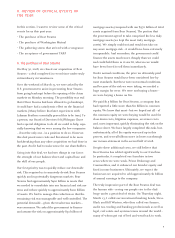JP Morgan Chase 2008 Annual Report Download - page 21
Download and view the complete annual report
Please find page 21 of the 2008 JP Morgan Chase annual report below. You can navigate through the pages in the report by either clicking on the pages listed below, or by using the keyword search tool below to find specific information within the annual report.19
ties. It also is likely that this process kept U.S. interest
rates very low, even beyond Federal Reserve policy, for
an extended period of time. It is likely that this excess
demand also kept risk premiums (i.e., credit spreads)
at an all-time low for an extended period of time. Low
interest rates and risk premiums probably fueled exces-
sive leverage and speculation. Excess consumption
could be financed cheaply. And adding fuel to the fire,
in the summer of 2008, the United States had its third
energy crisis – further imbalancing capital flows.
There have been times when large imbalances – such as
those in trade – sort themselves out without causing
massive global disruption. However, it is bad planning
and wishful thinking to assume that this will always be
the case. These imbalances shouldn’t be allowed to get
that large – they create too much potential risk.
Many other factors may have added to this storm – an
expensive war in Iraq, short-selling, high energy prices,
and irrational pressure on corporations, money man-
agers and hedge funds to show increasingly better
returns. It also is clear that excessive, poorly designed
and short-term oriented compensation practices added
to the problem by rewarding a lot of bad behavior.
The modern financial world has had its first major
financial crisis. So far, many major actors are gone:
many of the mortgage brokers, numerous hedge funds,
Wachovia, WaMu, Bear Stearns, Lehman and many
others. Some of the survivors are struggling, particular-
ly as we face a truly global, massive recession – and it
still is not over.
IV. THE FUTURE OF OUR SYSTEM
The extent of the damage and the magnitude of the
systemic problems make it clear that our rules and reg-
ulations must be completely overhauled. Such changes
to the regulatory system could have huge implications
on the long-term health, and strategies, of our business.
While unprecedented actions have been taken by both
the Federal Reserve and the Treasury, my hope is that
new policies are grounded in a thorough analysis of what
happened and what we need to do about it. Political
agendas or simplistic views will not serve us well.
Often we hear the debate around the need for more
or less regulation. What we need is better and more
forward-looking regulation. Someone has famously said
that a crisis should not go to waste. But what is also true
is that it shouldn’t take a crisis to solve our problems.
During a crisis, people panic. This can make it harder,
not easier, to do the right thing. From our perspective,
certain improvements would make a big difference. We
would like to share with you some of our suggestions.
A. The need for a systemic regulator with much
broader authority
We agree with our leaders in government that we
should move ahead quickly to establish a systemic reg-
ulator. In the short term, this would allow us to focus
attention on correcting some underlying weaknesses
in our system and filling the gaps in regulation that
contributed to the current situation. It also is clear that
U.S. policy must be coordinated with the proper set of
international regulators. When the crisis emerged, the
actions of individual countries had a critical impact on
numerous other countries. International coordination
is essential in resolving this kind of crisis.
There should be procedures in place to deal with
systemically important institutions – failure is fine
as long as it’s orderly and controlled and doesn’t cause
systemic failure
Size is not the issue; rather, it is when institutions are
too interconnected that an uncontrolled failure has the
potential to bring the whole system down. What we
need is a resolution process that allows failure without
causing damage to the whole system. In the case of Bear
























